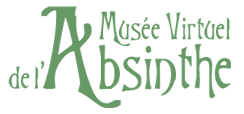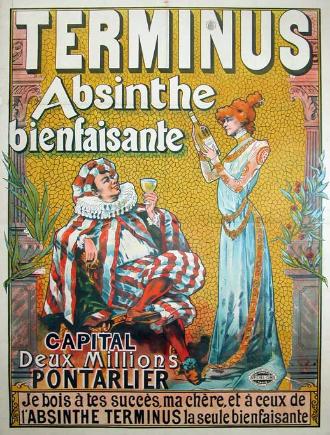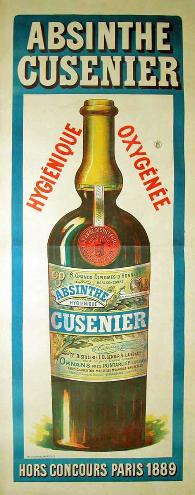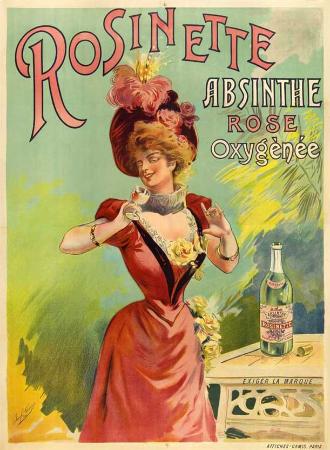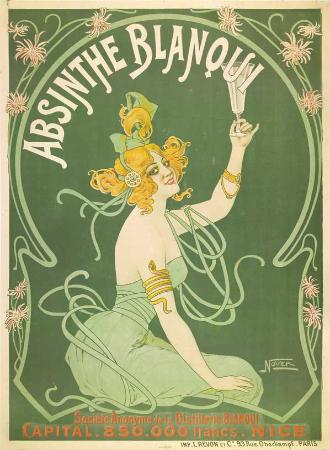| AFFICHES SUR L'ABSINTHE I |
L'explosion de l'absinthe à la fin du 19ème siècle coïncida avec l'avènement de la grande affiche de publicité
lithographique comme médium commercial et artistique essentiel -- avec comme pionnier Jules Chéret et ses oeuvres.
Certains des plus grands créateurs d'affiches de la période - Cappiello, Privat-Livemont, Tamagno - créèrent des
images célèbres pour la promotion des grandes marques. Heureusement, le plus grand d'entre eux,
Toulouse-Lautrec, ne produisit jamais une affiche spécifiquement dédiée à l'absinthe, épargnant aux futures
générations de collectionneurs d'articles liés à l'absinthe le besoin de se ruiner...
lithographique comme médium commercial et artistique essentiel -- avec comme pionnier Jules Chéret et ses oeuvres.
Certains des plus grands créateurs d'affiches de la période - Cappiello, Privat-Livemont, Tamagno - créèrent des
images célèbres pour la promotion des grandes marques. Heureusement, le plus grand d'entre eux,
Toulouse-Lautrec, ne produisit jamais une affiche spécifiquement dédiée à l'absinthe, épargnant aux futures
générations de collectionneurs d'articles liés à l'absinthe le besoin de se ruiner...
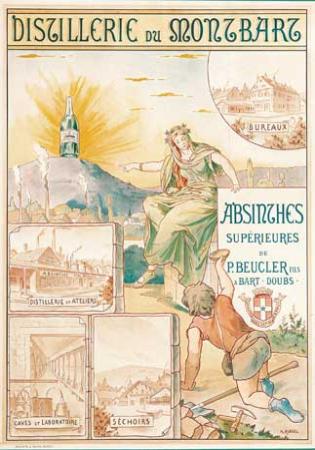
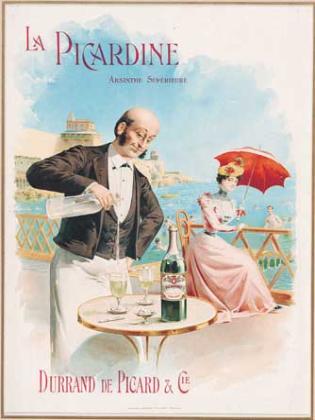
| Une image publicitaire pour l'Absinthe Picardine, précédemment non documentée, probablement publiée à l'origine dans le journal "L'illustration". La toile de fond montre la Corniche aux Catalans à Marseille. |
| Trouvée récemment dans une cache en Suisse, une affiche de taille moyenne pour les distilleries Montbart, dessinée par M. Ringel. 0.7m x 0.5m. |
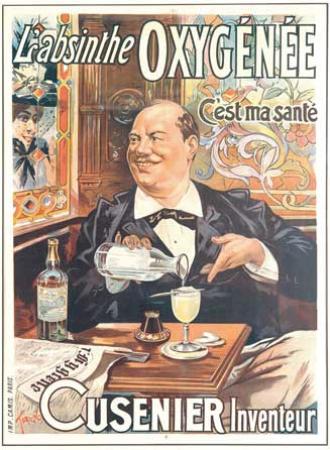
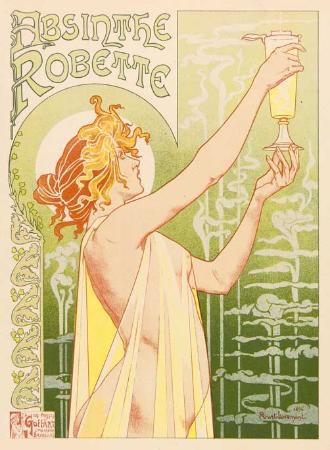
| Une des images art nouveau les plus iconiques qu'il y ait, cette image de 1896 pour l'Absinthe Robette, par le créateur d'affiches Belge Privat-Livemount, copiée à des millions d'exemplaires. |
| Une autre affiche bien connue, produite en 1896, dessinée par Nicholas Tamagno pour Cusenier. Le bon vivant savourant son absinthe Oxygénée est le comédien français Joseph-François Dailly (1839-1897). |
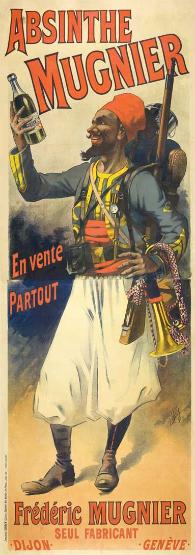
| Sur l'affiche de 1892 par Tamagno pour l'absinthe Terminus figurent deux personnalités de scène célèbres de l'époque: Constant Coquelin et Sarah Bernhardt. Bernhardt fut furieuse de se voir dépeinte sans avoir donné son accord, et poursuivit avec succès les fabricants en justice - après quoi ils furent forcés de faire enlever toutes les affiches des murs de Paris. Format : 1.28m x 0.98m. |
| Une affiche de 1895 par Lucien Lefèvre pour l'absinthe Mugnier. Format 2.50m x 0.86m. |
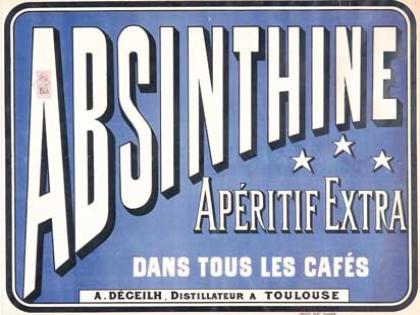
| Affiche pour l'Absinthine, basée à Toulouse, probablement un ersatz d'absinthe. |
| Une affiche lithographique sur deux feuilles pour l'Absinthe Cusenier. 1.90m x 0.71m. |
| Une affiche lithographique de 94 x 126 cm non répertoriée pour la Rosinette, une Absinthe Rose Oxygénée. C'est le seul témoignage historique connu ç ce jour prouvant l'existence d'une absinthe de couleur rose. Cliquez sur les images pour agrandir. |
| Une affiche pour l'Absinthe Blanqui au design art-nouveau très raffiné et fortement influencé par le mouvement très en voque à l'époque : l'orientalisme. Cette affiche originale est très rare, seulement 3 exemplaires sont connus à ce jour. Les dessins originaux de l'artiste pour cette affiche sont également visibles sur le Musée Virtuel. |
The height of the absinthe boom in the late 19th century, coincided with the rise of the large lithographic advertising poster as a
powerful commercial and artistic medium.
Although lithography was invented in 1796, it was at first too slow and expensive for poster production. Most posters were
woodblocks or metal engravings with little color or design. This all changed in the late 19th century with Jules Cheret’s development
of the stone-lithography process, a breakthrough which allowed artists to achieve every color in the rainbow with as little as three
stones - usually red, yellow and blue - printed in careful registration.
Stone lithography involved limestone blocks, or "stones," which were prepared by grinding and sanding the stone to a smooth
surface. Limestone was used because of its porosity. Once the stone was ready, the artist drew the image directly on the stone,
using a grease crayon and ink. The greasy crayon and ink set up an insoluble, grease-attracting and therefore water-repelling
condition on the stone wherever it was applied.
When the drawing was completed, the surface of the stone was covered with an acidified solution of gum arabic. This solution
desensitized the undrawn areas of the stone, making them incapable of further grease absorption. The stone was then placed on a
printing press, and dampened with water. The areas of the stone not covered by the greasy crayon become wet, while the greasy
areas of the drawing repelled the water and remained dry. An oil-based ink was then applied to the stone with a roller, adhering
only to the drawing and being repelled by the wet areas of the stone. Dampened paper was then placed on the inked stone over
which a flat board was laid. Pressure was then applied by running the stone through a press under a greased, leather covered
scraper which transferred the inked drawing to the paper. The whole process was then repeated for each of the 3 primary colours.
Although the technique was difficult to master, the result in expert hands was a remarkable intensity of color and texture, with
transparencies and nuances impossible to achieve in other media, and never equaled since, even to this day. Printing presses to
handle the huge stone blocks do not exist anymore, so printing of this quality in large format is no longer possible – one of the
reasons that, fortunately, fakes or forgeries are not generally a problem in this field.
The Absinthe Robette poster shown above, with its wonderfully subtle and translucent shades of green, is technically speaking, a
particularly superlative example of this lithographic printing process.
This ability to combine word and image in such an attractive and economical format made the lithographic poster a powerful
innovation. Starting in the 1870s it became the dominant means of mass communication France, and spread soon afterwards to
other countries, ushering in the modern age of advertising.
In 1891, Toulouse-Lautrec’s first poster, Moulin Rouge, elevated the status of the poster to fine art. In 1894, Alphonse Mucha, a
Czech working in Paris, created the first masterpiece of Art Nouveau poster design. Influenced by the Pre-Raphaelites, the Arts and
Crafts Movement, and Byzantine art, this style dominated the Parisian scene for the next ten years. Privat-Livemont was Mucha’s
chief follower.
The collecting of posters probably began soon after the first distribution of the posters themselves. Some art dealers believed they
could sell these "advertising" pieces to their customers. They sought out the poster artists and the printers in an effort to secure
over-runs. However, the vast majority of posters were destroyed in actual use. They were mounted on walls and merely discarded
or ripped away when the next new image became available. While the posters were originally produced in editions that usually
numbered in the hundreds or even thousands, very few survive in their original state. Those that survive in good condition today,
usually originate from printer’s archives discovered many decades later.
To buy rare original vintage absinthe posters visit our webshop.
powerful commercial and artistic medium.
Although lithography was invented in 1796, it was at first too slow and expensive for poster production. Most posters were
woodblocks or metal engravings with little color or design. This all changed in the late 19th century with Jules Cheret’s development
of the stone-lithography process, a breakthrough which allowed artists to achieve every color in the rainbow with as little as three
stones - usually red, yellow and blue - printed in careful registration.
Stone lithography involved limestone blocks, or "stones," which were prepared by grinding and sanding the stone to a smooth
surface. Limestone was used because of its porosity. Once the stone was ready, the artist drew the image directly on the stone,
using a grease crayon and ink. The greasy crayon and ink set up an insoluble, grease-attracting and therefore water-repelling
condition on the stone wherever it was applied.
When the drawing was completed, the surface of the stone was covered with an acidified solution of gum arabic. This solution
desensitized the undrawn areas of the stone, making them incapable of further grease absorption. The stone was then placed on a
printing press, and dampened with water. The areas of the stone not covered by the greasy crayon become wet, while the greasy
areas of the drawing repelled the water and remained dry. An oil-based ink was then applied to the stone with a roller, adhering
only to the drawing and being repelled by the wet areas of the stone. Dampened paper was then placed on the inked stone over
which a flat board was laid. Pressure was then applied by running the stone through a press under a greased, leather covered
scraper which transferred the inked drawing to the paper. The whole process was then repeated for each of the 3 primary colours.
Although the technique was difficult to master, the result in expert hands was a remarkable intensity of color and texture, with
transparencies and nuances impossible to achieve in other media, and never equaled since, even to this day. Printing presses to
handle the huge stone blocks do not exist anymore, so printing of this quality in large format is no longer possible – one of the
reasons that, fortunately, fakes or forgeries are not generally a problem in this field.
The Absinthe Robette poster shown above, with its wonderfully subtle and translucent shades of green, is technically speaking, a
particularly superlative example of this lithographic printing process.
This ability to combine word and image in such an attractive and economical format made the lithographic poster a powerful
innovation. Starting in the 1870s it became the dominant means of mass communication France, and spread soon afterwards to
other countries, ushering in the modern age of advertising.
In 1891, Toulouse-Lautrec’s first poster, Moulin Rouge, elevated the status of the poster to fine art. In 1894, Alphonse Mucha, a
Czech working in Paris, created the first masterpiece of Art Nouveau poster design. Influenced by the Pre-Raphaelites, the Arts and
Crafts Movement, and Byzantine art, this style dominated the Parisian scene for the next ten years. Privat-Livemont was Mucha’s
chief follower.
The collecting of posters probably began soon after the first distribution of the posters themselves. Some art dealers believed they
could sell these "advertising" pieces to their customers. They sought out the poster artists and the printers in an effort to secure
over-runs. However, the vast majority of posters were destroyed in actual use. They were mounted on walls and merely discarded
or ripped away when the next new image became available. While the posters were originally produced in editions that usually
numbered in the hundreds or even thousands, very few survive in their original state. Those that survive in good condition today,
usually originate from printer’s archives discovered many decades later.
To buy rare original vintage absinthe posters visit our webshop.
| Copyright © 2002 - 2015 Oxygenee (France) Ltd. Aucune image ou texte ne peut être reproduit ou employé, sous aucune forme, sans une permission écrite du propriétaire de ce site web. |
